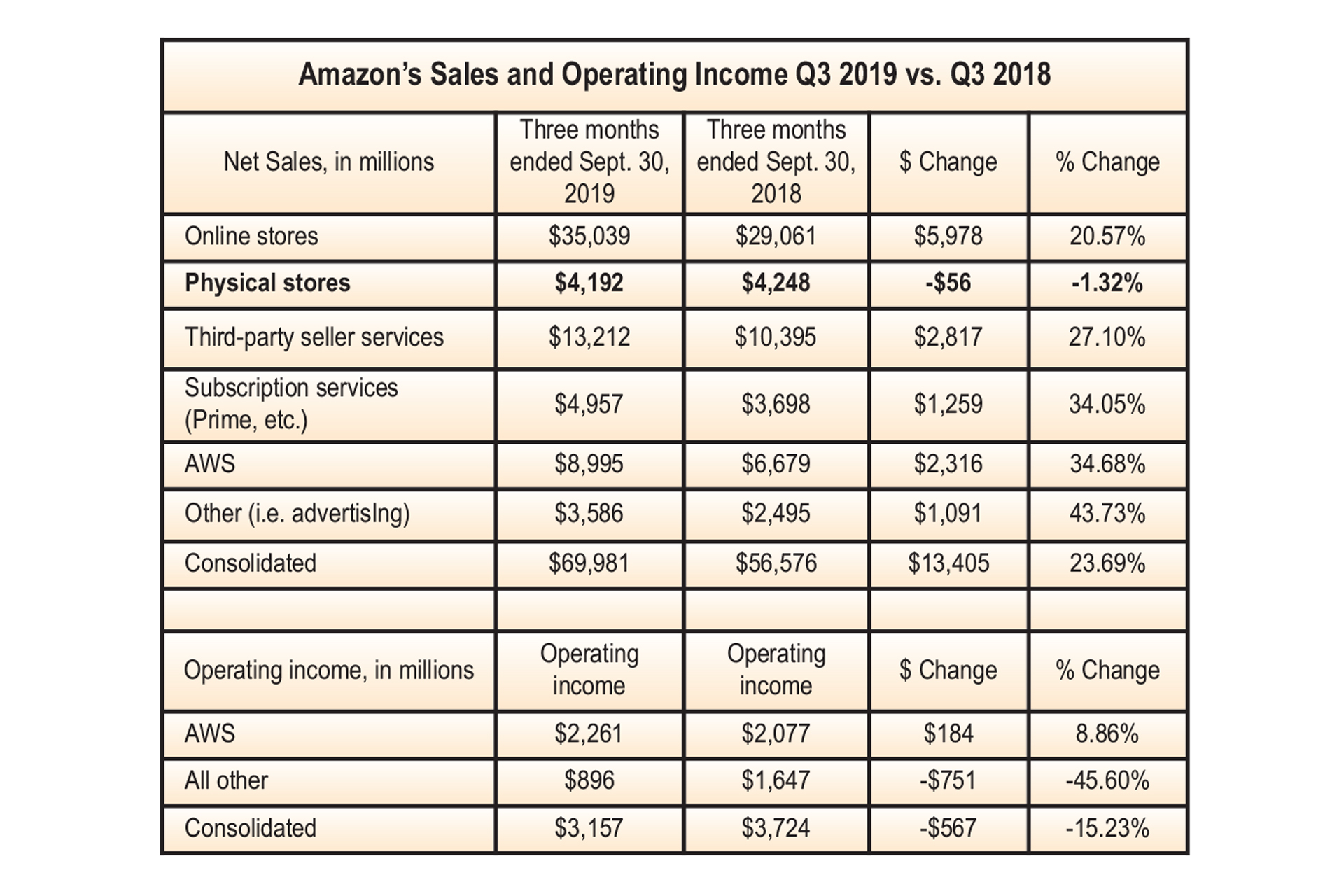In late October, the company reported an overall 24% increase in revenues during its third-quarter (Q3) compared to the same period last year. Revenues in Q3 were $69.9 billion, and for all of 2019, will easily crest $200 billion.
Amazon reported profits in Q3 of about 4.5%. Most of these profits, however, don’t come from the 87% of its sales tied to its real-world business of selling and delivering products to shoppers. Instead, most profits (71.6%) continue to come from the 13% of its business that is virtual: Amazon Web Services, or AWS; the company’s wholesale cloud-computing services to corporations and governments.
Related: Reality speaking: The Vulnerabilities of Amazon and Online Retail
Amazon’s physical stores make up 6% of overall company sales, or $4.19 billion (see table), but those sales declined $56 million compared to Q3 last year. The vast majority of Amazon’s physical store sales come from Whole Foods’ 500-some-odd locations. In 2017, the year Amazon acquired Whole Foods, the chain’s sales were just under $16 billion (our estimate). As you can see, Amazon’s physical store sales have barely budged in the two years since.Here’s a look at Amazon’s overall sales and income, by product and service group, in Q3 2019, compared to Q3 2018:

Online Sales Up, Physical Stores DownAs you can see from the table, online sales in Q3 were up nearly $6 billion, a 21% increase, while physical store sales were down 1.3%. Amazon accounts for products ordered online and shipped from, or picked up at, Whole Foods physical stores as “online store” sales, so Whole Foods physical stores don’t get full credit for products taken off its shelves to fill orders that originated online.
What this Q3 report confirms is that making Whole Foods’ product catalog available online has not driven an increase in Whole Foods’ physical store visits by customers. Anecdotal reports are emerging that the opposite is happening. Because of Amazon’s same-day, and now even two-hour Prime member food deliveries, Whole Foods aisles are crowding up with online-order pickers, grabbing up the fresh salmon filets before regular shoppers can get them. This has turned off some formerly regular Whole Foods shoppers (1).
Expensive Warehouse SpaceIn effect, Amazon is converting Whole Foods physical stores into very expensive warehouse space to fulfill these online orders. Whole Foods’ leases include some of the most expensive commercial real estate in the country. Lease rates in Chicago, Los Angeles, New York, San Francisco, and other major metropolitan areas run into the hundreds-of-dollars per square foot. If Amazon’s delivery programs discourage regular bricks-and-mortar shoppers—those who traditionally came to Whole Foods for the enjoyment, and to be seen by their neighbors—it needs a Plan B.
Recent reports have Amazon looking for cheaper retail store space in urban, suburban, and lower-population-density cities in the U.S. We assume the company wants to lower lease costs so that it can execute its hybrid shop-and-pick physical store concept (see WholeFoods Magazine,September Merchandising Insights). One part of these stores, which will contain mostly fresh perishables foods, will be true retail space where customers can squeeze the tomatoes. The other part will be a fulfillment warehouse, stocking mostly shelf-stable foods and household non-foods, operated by Amazon pickers. As shoppers complete their fresh-food rounds, pickers from the non-retail warehouse side of the store will meet them at the checkout point to marry their non-perishables online orders with their perishables.
This was the new physical store concept Amazon was contemplating in early spring 2017, just before the Whole Foods opportunity presented itself. Apparently tabled for the last two years as the company digested the Whole Foods acquisition, Amazon now appears to be reactivating the idea with leases of cheaper commercial real estate in the same cities where Whole Foods stores are located. Is this redundancy really what Amazon CEO Jeff Bezos planned all along?
Related: Amazon Plans Grocery Expansion, WSJ Reports
“We seek to reduce our variable costs…”In the company’s 2018 annual report, Amazon describes its long-term financial focus as a way to reduce variable costs, which includes reducing “customer service support” costs. To minimize fixed costs, the company will “maintain a lean culture.” In addition to increasing spending on technology specialists, the company will invest in “merchandisingemployees,” and in “technology infrastructureto enhance the customer experience.” [italics mine]Do you imagine the Whole Foods sommeliers and cheesemongers reading this statement from Amazon will have a warm, fuzzy feeling about job security? With 3,000 Amazon Go cashierless, interaction-less convenience stores planned for 2021, it’s pretty clear that efficiency—not the quaint human touch of Whole Foods—will drive Amazon’s future.
Takeaway Tip:Unless you have a spare billion dollars or two to invest in technology, human touch is still the best route to a survivable business model for independent retailers.WF
References
1)Wall Street Journal,“Feel Like You’re the Only One at Whole Foods Buying Your Own Groceries? Possibly. Amazon offers its Prime members grocery delivery, causing store shoppers to balk; ‘chaos’,” October 28, 2019, Heather Haddon and Jaewon Kang










